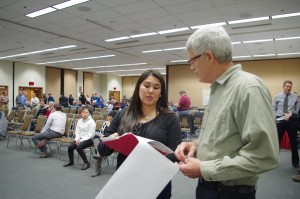
The Board of Fisheries’ new coastal change committee will hold its first meeting next month. The committee is helping the board develop some guidelines for how it deals with commercial fishing boundaries that change along with Alaska’s coastline.
Download Audio
Changes to Alaska’s coastline and creeks could affect fishing boundaries, but the state Board of Fisheries is waiting to weigh in on possible fixes until a new committee can delve into the issue.
BOF Executive Director Glenn Haight said the new committee will hold a preliminary scoping meeting Jan. 4.
“The committee was set up to help develop criteria that the board can use when it’s dealing with proposals that are impacted by coastal erosion, and so really it’s not like any other list of criteria the board may look at when it deliberates on certain proposals,” he said. “They have the allocation criteria and the sustainable salmon criteria they follow when they deal with those types of proposals, so this would be similar to that.”
Call-in sites will be available at the Dillingham and King Salmon Fish and Game offices, as well as in Fairbanks, Juneau and Anchorage. Individuals can also provide public testimony via teleconference, but must sign up to do so by Jan. 2. Written comments are also being accepted through Jan. 2.
This is just the first meeting, Haight said.
“The committee needs to wrap its arms around all the aspects that affect these kinds of decisions, whether they’re related to DNR issues, legal issues, enforcement issues, people’s historical use patterns, and things that are happening because of coastal erosion,” Haight said. “They need to put their arms around all of that and try to develop criteria.”
The committee was formed at the Bristol Bay finfish meeting in Anchorage in early December, when the board heard testimony from several set-netters asking the board to make their sites whole after time and tides have taken their toll.
No one questions whether Dick Armstrong fished the first Graveyard Point sites for decades. But over time, boundary markers have moved and Graveyard Creek has shifted its course, and the family says the sites they have fished for decades are no longer part of the legal Naknek-Kvichak fishing district. So the entire and extended Armstrong clan asked the board to change a boundary at Graveyard Point.
At Clark’s Point, the opposite has occurred: the mud flats have filled in, reducing the fishing time for several sites. So set-netters asked the board to allow them to put their nets farther out into the ocean. That proposal was submitted by Alannah Hurley, with support from those at most adjacent sites, and others in the region.
The board tabled those requests, instead forming a new committee to consider just how the board should react to environmental change, whether it occurs in Bristol Bay or elsewhere on Alaska’s coast. Board chair Tom Kluberton, of Talkeetna, proposed waiting and forming the committee instead.
“I think it’s a really important thing for us to address,” Kluberton said at the meeting. “We know these things came on over a long period of time, but after this meeting I’m absolutely certain we’re going to see an ever-increasing volume of these kind of things.”
The new committee is tasked with developing a set of criteria for the board to consider when they look at regulation changes due to erosion issues, new coastline, lost coastline, and similar issues. Board members Reed Morisky, who has experience with construction, and Robert Mumford, who has enforcement experience, were named as members, and asked to consult with the state’s Department of Natural Resources and Department of Law. Other board members also said they wanted to participate in the committee’s meetings.
The board discussed having the committee work quickly to address the issues, but did not commit to a firm timeline, in part because Kluberton said they couldn’t control the schedules of the other departments.
The committee is expected to report back on its progress at the board’s January meeting, in Fairbanks, focused on the Arctic-Yukon-Kuskokwim region. Haight said there will likely be another meeting after the committee’s first meeting in January.
The board’s action is a little slower than what set-netters were looking for, and it’s unclear if the issues will wind up resolved before next summer.
Dillingham’s Janet Armstrong-Schlagel said she had hoped the board would take action at this meeting to fix the issue, but understood the board’s choice to be more deliberate.
“But at this meeting we have heard of many other areas that have suffered the erosion,” she said. “I didn’t realize that so many other setnetters were affected by it. So I think that if we are going to set the precedent, we can do it for the benefit of many people. So it’s frustrating that we did not get a resolution, but I’m encouraged that they aren’t just kicking it down the road.”
Board member Fritz Johnson, a drift permit holder from Dillingham, said he would’ve preferred the board take swifter action to fix a known problem, but accepted that the committee approach was appropriate.
“I wish we could solve this problem immediately for the folks on this beach, but I’m guessing that what has been suggested is that we take a broader view and a longer-term view because we will be facing this situation again I’m sure,” he said.
Board members referenced again and again that their action could set a precedent for how they respond to similar situations in the future – that was heard in public testimony during the meeting, too.
Although the issue at each site is a little different, Armstrong-Schlagel said they’re all in the same boat.
“It’s a pretty emotional thing,” she said. “We’re not just talking about lines, we’re talking about people’s livelihoods.”




